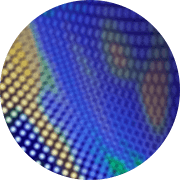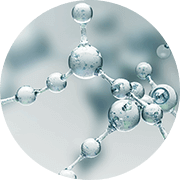Research
Summary
Our aim is to create new functionalmaterials and develop high-performanceand highly-durablematerials through molecular simulations
Our aim is to create new functional
materials and develop high-performance
and highly-durable
materials through molecular simulations
Nowadays, computer science is applied to various fields as a state-of-the-art science technology as well as experiments/observations and theory. We are focusing on four main research topics based on the understanding from atomistic point of view.
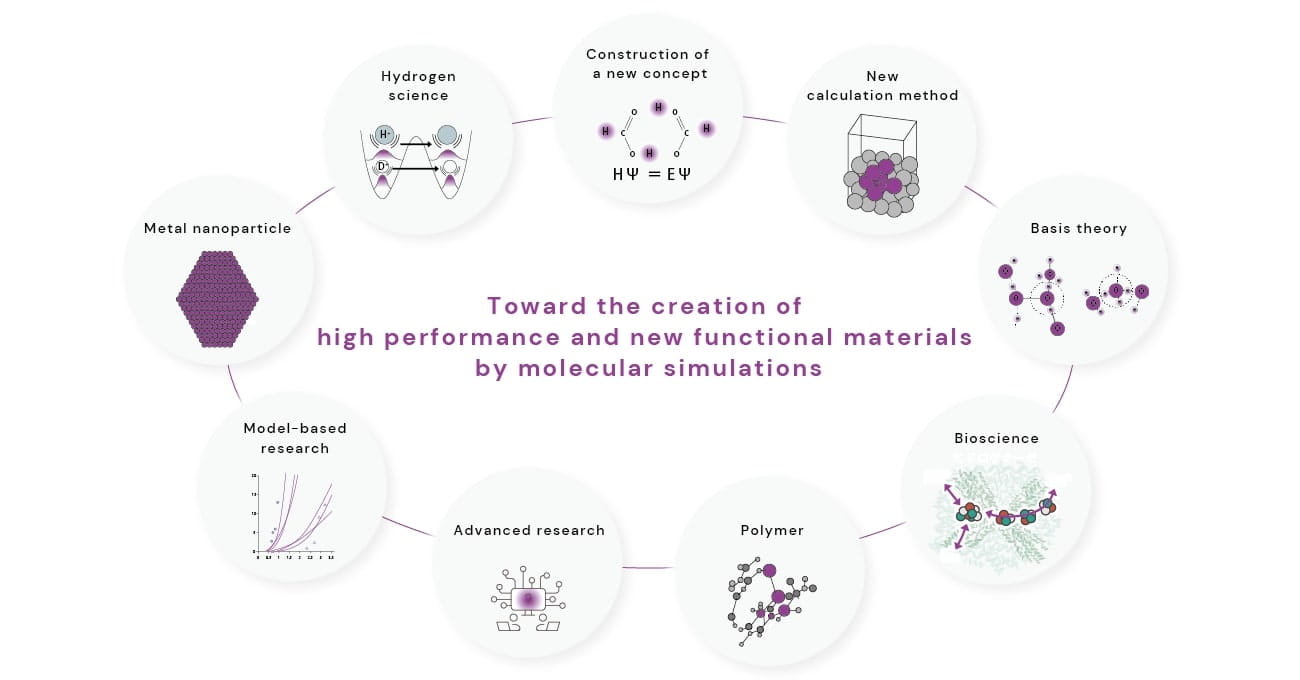
01
Development of high accurate calculation method for inhomogeneous environment and its application
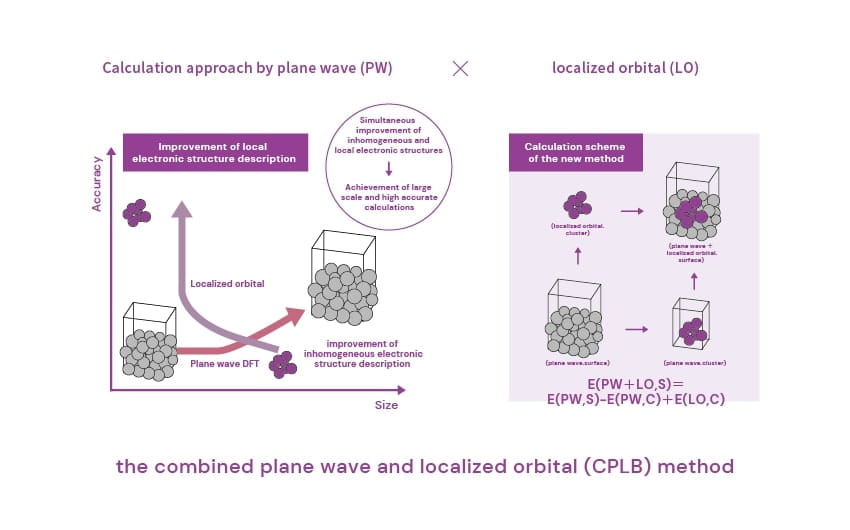
Highly accurate electronic structure calculations for nm order systems that reflect the real structures are necessary for nano material research. Although the calculation method based on the plane wave (PW) is widely used for the electronic structure calculations of bulk and surface models, this approach is sometimes difficult to describe the local chemical and physical events, such as adsorption and chemical reaction in inhomogeneous systems with reliable accuracy. On the other hand, because calculation method based on the localized orbital (LO) is highly accurate, it is expected to understand chemical and physical phenomena from the concept of the orbital picture. However, this approach is difficult to apply to large systems due to computational limitations. Now we are developing the combined plane wave and localized orbital (CPLB) method to achieve large-scale calculations with high accuracy.
References
- Hiroki Sakagami, Masanori Tachikawa, and Takayoshi Ishimoto, “Theoretical study of H/D isotope effect of CH4/CD4 adsorption on Rh(111) surface using combined plane wave and localized basis sets method” RSC Advances, 11, 10253-10257 (2021).
- Takayoshi Ishimoto and Hiroyuki Kai, “Combined plane wave and localized orbital electronic structure calculation: Adsorption energy of hydrogen on Pd(111)” International Journal of Quantum Chemistry, 118, e25452 (2018).
02
Development of calculation method for deuterium science and its application

It is considered that deuterium has the same properties as the hydrogen except for mass difference because deuterium is an isotope of hydrogen. However, it is evident from experiments that deuterium has different properties, especially hydrogen bond structures, chemical reactions, ionization potential, and so on. Although accurate electronic structure calculations for deuterium compounds are necessary to solve these problems, the conventional electronic structure calculations based on Born-Oppenheimer (BO) approximation are difficult. We are developing the non-BO type electronic structure calculation approach to treat the nuclear quantum effect directly.
References
- Yuka Kimura, Yusuke Kanematsu, Hiroki Sakagami, David, Samuel Rivera Rocabado, Tomomi Shimazaki, Masanori Tachikawa, and Takayoshi Ishimoto, “Hydrogen/deuterium transfer from anisole to methoxy radical: A theoretical study of a deuterium-labeled drug model” Journal of Physical Chemistry A, 126, 155-163 (2022).
- Takayoshi Ishimoto, Masanori Tachikawa, and Umpei Nagashima “Review of multicomponent molecular orbital method for direct treatment of nuclear quantum effect” International Journal of Quantum Chemistry, 109, 2677-2694 (2009).
03
Material development based on model-based research
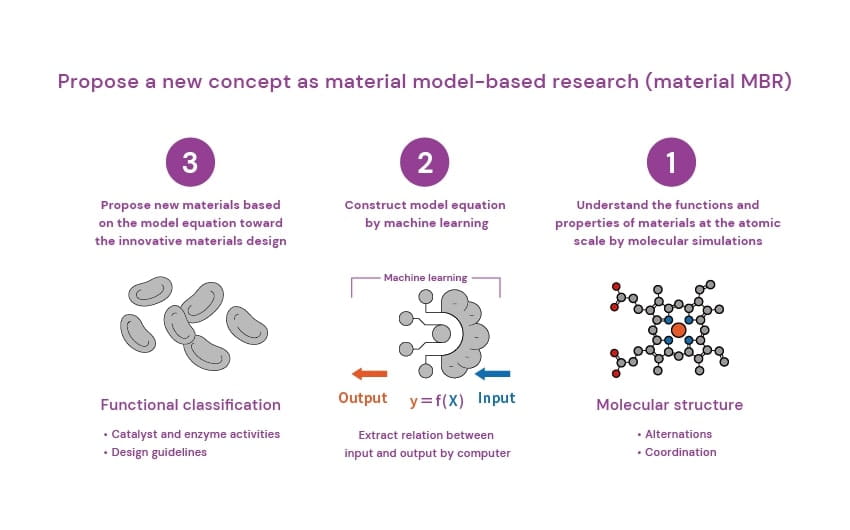
The creation of innovative materials is necessary for a carbon-neutral society and an energy-saving society. However, for example, simultaneous control of heat resistance and thermal conductivity of thermal management materials is difficult by try and error or by the researchers' experience. We are proposing the material model-based research (material MBR) as a new concept to develop new materials based on understanding materials' fundamental and basic properties. In the material MBR, measurable physical and chemical properties are mathematically modeled by the explanatory parameters obtained by the computer simulation from an atomistic point of view.
04
Research and development by industry-academia collaboration

We are challenging the research basis for business solutions through collaboration with companies. Please feel free contact us.
References
- Osamu Kobayashi, Kunihiko Noda, Naohiko Ikuma, Dai Shiota, Takayoshi Ishimoto and Masanori Tachikawa, “Experimental and computational analyses of the oxidation mechanism of the poly(arylsilane) family as the side reaction during the baking process” Journal of Physical Chemistry C, 124, 16149-16158 (2020).
- Yasuhiro Matsumura, Yuki Koda, Hiroshi Yamada, Masahiko Shigetsu, Akihide Takami, Takayoshi Ishimoto, and Hiroyuki Kai, “Experimental and computational studies of CO and NO adsorption properties on Rh-based single nanosized catalysts” Journal of Physical Chemistry C, 124, 2953-2960 (2020).

